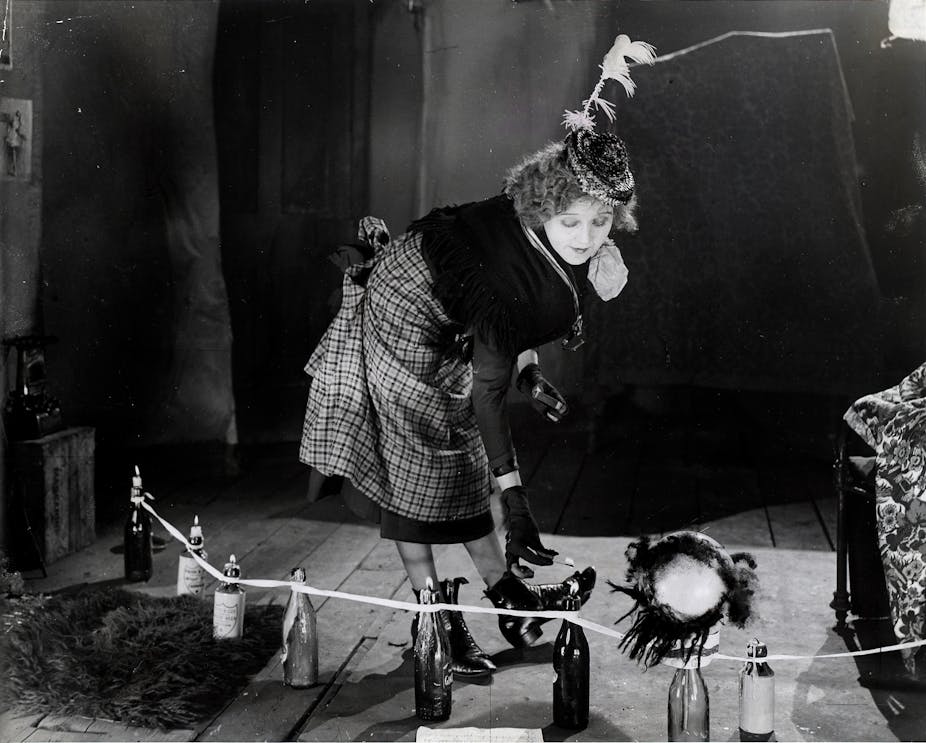The discovery of 1923 British silent film Love, Life and Laughter, widely hailed as a “lost masterpiece”, is exciting in returning a film celebrated upon its release as a highpoint in British cinema.
Fantastic news, but one wonders just how many such films have been lost in the past. Indeed, it has been estimated that around 80% of Britain’s silent heritage has been lost, and this in all probability echoes the global situation. A report for the Library of Congress recently put the figure of 75% on America’s silent cinema losses.
The reasons for these losses are various. Many silent films were destroyed when nitrate film stock was recycled to extract its valuable silver content, and many studios, before the full establishment of national archives, failed to recognise the artistic and cultural worth of silent features once synchronised sound film became the norm. Nitrate’s unfortunate combustibility did not help either.
As vigilance is evidently key to increase the chances of discovery, the BFI launched its list of 75 “Most Wanted” lost films in 2010, from which Pearson’s film can now be removed. The list is the successor to the 1992 “Missing, Believed Lost” campaign, which helped locate 15 of the 100 films listed.
The Most Wanted list has been hailed by Martin Scorsese as “the kind of initiative that every country should undertake”. Also on the eclectic list are another 1923 Pearson feature called Reveille, Sherlock Holmes’ first appearance in British cinema in A Study in Scarlet and Alfred Hitchcock’s second film, The Mountain Eagle. There is even a film called Where is Parsifal? that is as recent as 1983. This was the first title to be located. It is good to know that some of these films are misplaced rather than lost, and all that is needed is for the publicity to join the dots – sometimes even with the help of eBay – between the film and the archive.
There have been other recent discoveries. Gloria Swanson and Rudolph Valentino fans were delighted in 2003 to learn of the discovery of Beyond the Rocks (1922), coincidentally also from a collection of reels donated to EYE, who found Love, Life and Laughter. And in 2010 a major haul of silent features was located in the vaults of the New Zealand Film Archive.

There is also the wider search for lost radio and TV shows. In late 2013 fans of the BBC’s Doctor Who television series received the much-rumoured news that nine missing 1960s episodes, the tapes having been wiped for re-use due to an old BBC archive policy abandoned in 1978, had been discovered in a TV relay station storeroom in Nigeria.
While it is hard to avoid the reality that the majority of silent film production will never be seen again, these remarkable discoveries demonstrate that there is still material to be found. What’s more, while finding these films is important in itself, the buzz of excitement surrounding these announcements indicates that there is a need for us to find them that exceeds their undoubted cultural and artistic merit.
When a missing film is restored to us, it perhaps represents not only a reassurance that the past has not been entirely lost, but a reminder of the almost miraculous phenomenon of cinema itself. Film is an art that captures photographs, and then magically brings these still images of the past to life at 24 frames per second (or as low as 16 in the silent era).
It is a phantasmagoric feat that has captivated audiences since the Victorian age. When a film has been “lost”, and then found, and especially at the point of almost being lost forever to the rubbish tip, as with the latest discovery, the effect has an added historical resonance. It is not only that a film has been returned to us, but a slice of the past.
If rediscovered “classics” gain an added an aura because of their loss, they also have much to live up to. As the BFI’s Curator of Silent Film, Bryony Dixon, puts it:
Contemporary reviewers and audiences considered Life, Love and Laughter to be one of the finest creations of British cinema, it will be thrilling to find out if they’re right!
Film critic CA Lejeune’s 1923 review of Love, Life and Laughter described it – evocatively for a lost film – as being “lit and photographed with a beauty to dream of”. We need dream no longer; the BFI are soon hoping to screen footage to British audiences for the first time in more than 90 years. It will be quite an experience.

